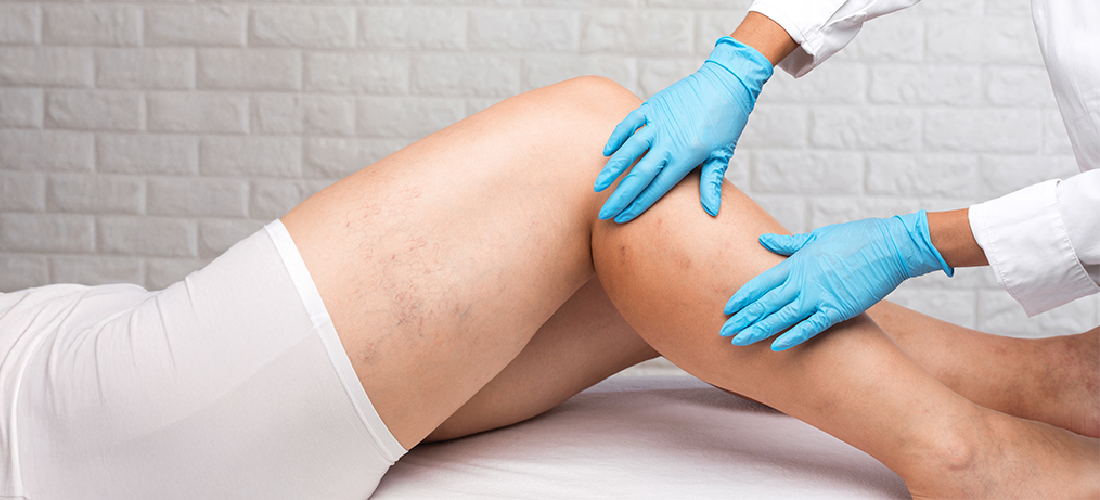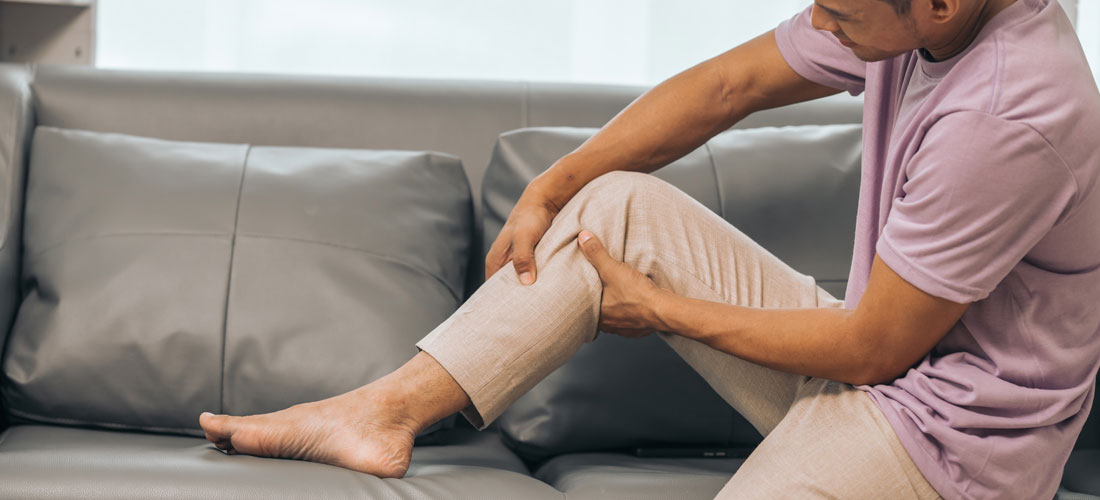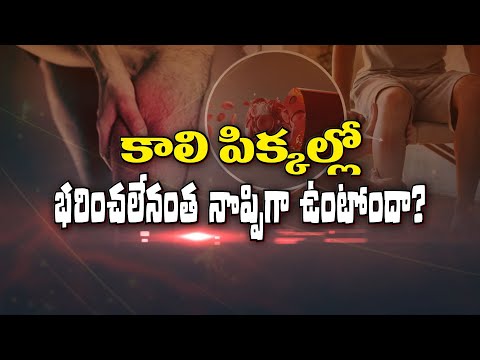Chronic Venous Insufficiency (CVI)
Chronic venous insufficiency (CVI) is a long-term condition that affects the veins in your legs. Normally, the veins carry blood back to your heart with the help of tiny one-way valves. In CVI, these valves become weak or damaged, causing blood to flow backward and pool in the leg veins. Over time, this increases pressure in the veins, leading to swelling, discomfort, and skin changes.
CVI can affect:
- Deep veins - larger veins located deep within your muscles.
- Superficial veins - veins close to the surface of your skin.
- Perforator veins - which connect the deep and superficial systems.
Initially, symptoms may be mild, but if left untreated, CVI can progress and cause pain, ulcers, and significant lifestyle limitations.
Chronic Venous Insufficiency vs. Post-Thrombotic Syndrome
Both conditions result from damaged veins, but the underlying cause differs.
- Post-thrombotic syndrome (PTS) is a type of CVI that develops after deep vein thrombosis (DVT) — a blood clot in the deep veins of the leg.
- The clot can damage the vein’s valves, leaving scar tissue that impairs circulation.
Studies show that 20%–50% of people who experience a DVT go on to develop post-thrombotic syndrome, often within one to two years.
How common is Chronic venous insufficiency (CVI)?
Venous disorders are among the most common vascular problems worldwide.
- Varicose veins affect roughly 30–35% of adults, and about 1 in 50 people with varicose veins may develop CVI each year.
- Globally, around 5% of adults are estimated to have CVI, with higher rates among older adults and women.
- In India, venous disease is increasingly recognized, especially among people who stand for long hours, such as teachers, factory workers, and healthcare professionals.
Chronic venous insufficiency (CVI) becomes more common with age (over 50 years) and with other risk factors like obesity or a sedentary lifestyle.
Symptoms
Aching, heaviness, or tiredness in the legs
Swelling in the lower legs or ankles, especially after standing or at day’s end
Burning, tingling, or “pins and needles” sensations
Night-time leg cramps
Discolored, reddish-brown skin (due to blood leakage under the skin)
Itchy, dry, or flaky skin on the legs or feet
Thickened, leathery skin texture
Varicose veins
Open sores or venous ulcers, usually near the ankles
Severe or long-standing swelling can lead to skin hardening and ulcers that heal poorly without medical care.
Stages of Chronic Venous Insufficiency (CVI)
Venous disorders are graded on a clinical scale from 0 to 6, depending on visible signs and severity:
- Stage 0: No visible changes, but symptoms like heaviness or fatigue may occur.
- Stage 1: Spider veins (tiny visible veins).
- Stage 2: Varicose veins larger than 3 mm.
- Stage 3: Leg swelling (edema) without skin changes.
- Stage 4: Skin color or texture changes.
- Stage 5: Healed ulcers.
- Stage 6: Active ulcers.
CVI is typically diagnosed from stage 3 onwards. Having varicose veins doesn’t always mean you have CVI, but it signals early vein dysfunction that should be monitored.
Causes
CVI occurs when the vein valves fail and can no longer prevent blood from flowing backward, a condition known as venous reflux.
Causes include:
- Congenital: Vein abnormalities present from birth (rare).
- Primary: Valve weakness or vein dilation without another disease.
- Secondary: Resulting from another condition, most commonly deep vein thrombosis (DVT). The clot damages the vein and leaves scar tissue that prevents the valve from closing properly. In India and worldwide, deep vein thrombosis (DVT) remains the leading cause of chronic venous insufficiency.
Risk factors
You are more likely to develop CVI if you have:
- A history of DVT (the most significant risk)
- Varicose veins or family history of vein disease
- Obesity
- Pregnancy (due to hormonal and circulatory changes)
- Prolonged sitting or standing (common in desk or service jobs)
- Smoking or tobacco use
- Lack of physical activity
- Age over 50
- Female gender
- May-Thurner syndrome (a structural vein compression disorder)
Prevention
You can’t always prevent CVI, especially if it’s genetic or post-DVT. However, healthy lifestyle habits can lower your risk:
- Stay active as regular walking improves leg muscle tone and circulation.
- Maintain a healthy weight.
- Avoid prolonged sitting or standing. Take breaks to move around.
- Quit smoking.
- Limit salt intake to prevent fluid retention.
- Wear compression stockings if prescribed, especially if you have varicose veins or a history of DVT.
Diagnosis
Diagnosis involves a combination of clinical examination and imaging tests:
- Physical examination: Your doctor will assess swelling, skin color changes, varicose veins, or ulcers.
- Doppler or Duplex ultrasound: This non-invasive test visualizes blood flow in your veins and checks for valve damage or clots.
Sometimes, additional tests such as MRI venography may be used to evaluate deep venous obstruction.
Because CVI and peripheral artery disease (PAD) can coexist, vascular specialists often check for both conditions before recommending compression therapy.
Complications
Without proper treatment, chronic venous insufficiency (CVI) can cause long-term damage due to sustained high pressure in the veins.
- Inflammation and tissue damage
- Skin discoloration and thickening
- Venous ulcers, especially around the ankles
- Cellulitis (skin infection) from ulcer-related wounds
Venous ulcers can be painful, slow to heal, and prone to infection — one of the main reasons early intervention is essential.
Treatment options
Treatment aims to improve blood flow, reduce symptoms, and prevent ulcers or recurrence. Management is personalized based on disease stage and overall health.
Lifestyle changes
First-line management includes:
- Leg elevation: Raise legs above heart level for 20–30 minutes, 2–3 times daily.
- Exercise: Walking activates your calf muscles. They are known as the “second heart” that helps pump blood upward.
- Weight management: Reduces pressure on your veins.
Compression therapy
Compression stockings or bandages are the cornerstone of CVI management. They reduce swelling, support the veins, and improve circulation.
- Graduated compression stockings are tighter at the ankle and looser toward the thigh.
- Intermittent pneumatic compression (IPC) sleeves may be used in severe cases.
If you have PAD, compression must be used cautiously and only under medical supervision.
Medications
Medications may include:
- Antibiotics for infected ulcers
- Anticoagulants (blood thinners) for patients with DVT history
- Topical medications or Unna boots (zinc-based dressings) for ulcer healing
Nonsurgical minimally invasive treatments
- Sclerotherapy: Injection of a solution to close small varicose or spider veins.
- Endovenous thermal ablation: Laser or radiofrequency heat seals off diseased veins with minimal discomfort and downtime.
Surgical treatments
When conservative measures are insufficient:
- Ligation and stripping: Tying off and removing damaged veins.
- Ambulatory phlebectomy: Minimally invasive removal of surface varicose veins.
- Subfascial endoscopic perforator surgery (SEPS): Closes leaking perforator veins near the ankle to help ulcers heal.
- Vein bypass: Used rarely for severe cases where blood must be rerouted around blocked veins.
Long-term care and living with Chronic Venous Insufficiency (CVI)
CVI is a chronic condition, but with consistent care, most people can manage symptoms and maintain a good quality of life.
Self-care tips:
- Avoid long periods of sitting or standing. Move or flex your ankles every 30 minutes.
- Check your skin daily for color changes or ulcers.
- Elevate your legs when resting.
- Walk regularly to strengthen your calf muscles.
- Maintain a healthy weight.
- Keep your skin clean and moisturized.
- Wear compression stockings as prescribed.
While CVI cannot be completely reversed, timely treatment can stop progression, relieve symptoms, and prevent complications like ulcers.
How Chronic Venous Insufficiency (CVI) is treated at RIVEA
While chronic venous insufficiency (CVI) can’t be permanently “cured,” it can be effectively managed. Modern treatments focus on improving circulation, relieving symptoms like swelling and heaviness, healing skin changes or ulcers, and preventing progression. At RIVEA Vascular Institute, most treatments are minimally invasive, performed in our advanced hybrid operating theatre, and allow you to return home the same day.
When lifestyle measures and compression therapy aren’t enough, image-guided, minimally invasive procedures can close the diseased veins and redirect blood flow through healthier ones. These procedures are done under local anesthesia with minimal discomfort and no hospital stay.
- VenaSeal™ (Glue Ablation):
A small catheter is inserted into the affected vein, and a medical-grade adhesive is used to seal it shut. This approach requires no heat, tumescent anesthesia, or stitches, and recovery is almost immediate — most patients walk out within an hour. - Endovenous Thermal Ablation (Laser or Radiofrequency):
Heat energy delivered through a fine catheter closes off faulty veins. It’s a highly effective, ultrasound-guided treatment that offers lasting relief from symptoms with minimal downtime. - Sclerotherapy:
A safe chemical solution is injected into smaller varicose or spider veins, causing them to collapse and gradually fade. It’s especially effective for cosmetic improvement and early-stage CVI. - Perforator Vein Ablation:
In patients with advanced CVI, malfunctioning perforator veins (which connect superficial and deep veins) can contribute to skin darkening, swelling, and ulcers. Using either laser, radiofrequency, or chemical ablation, these veins are closed internally to restore normal circulation and promote healing.
Thanks to modern endovenous therapies, surgery is rarely needed today. However, in severe or recurrent cases, it may still be considered.
- Ligation and Stripping:
The affected vein is tied off and, if necessary, removed through small incisions to prevent recurrence. This is performed under anesthesia and typically reserved for patients where minimally invasive methods are unsuitable.
Why choose RIVEA for Chronic Venous Insufficiency (CVI) and Venous Disease Care
RIVEA Vascular Institute is one of India’s leading centers dedicated to comprehensive vascular, endovascular, and interventional radiology care. We provide expert management for the full spectrum of venous conditions — including chronic venous insufficiency, varicose veins, deep vein thrombosis (DVT), and peripheral arterial disease (PAD).
Our vein care is led by Dr. Karthik Mikkineni, an American Board of Surgery–certified vascular surgeon with specialized training in advanced, image-guided venous and arterial therapies. Every treatment is planned with precision, guided by ultrasound and high-definition imaging to ensure accuracy and safety.
At RIVEA, you benefit from:
- Board-Certified Expertise: Treatment by American Board–certified vascular and endovascular specialists.
- Advanced Imaging Capabilities: High-resolution ultrasound, 3D imaging–capable cath lab, and precision-guided tools for diagnosis and therapy.
- Tailored Treatment Plans: Personalized care based on your vein anatomy, disease stage, and lifestyle.
- Minimally Invasive Precision: Outpatient procedures with little to no downtime, minimal pain, and faster recovery.
- Comprehensive Vascular Care: Integrated management of CVI, DVT, and PAD for better circulation and long-term limb health.
- Proven Outcomes: Long-lasting relief from leg pain, swelling, and heaviness, along with improved skin tone and leg appearance.
Click here to learn more about:
Varicose Veins
For any inquiries, post your query here:
Ask Rivea
Contact us today to explore your options.
Call Now
Our Team
-

Dr. Karthik Mikkineni
MD, FACS, FSVS, RPVI
Dr. Karthik Mikkineni is an internationally recognized vascular and endovascular surgeon, known for his pioneering work in complex aortic interventions, limb salvage, and carotid disease management.
View Profile Book an Appointment



